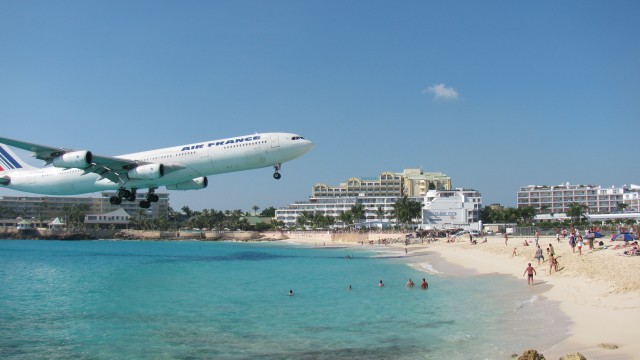
Terry Kraabel took this photo of an Air France jet landing at the Saint Marteen airport in the Caribbean.
I grew up reading Airways Magazine (and still do today) and it probably helped to inspire me to start my blog. This January they are doing something pretty epic and you should join them.
From January 12-19th, 2013, Airways will be hosting a Caribbean Cruise for AvGeeks. The trip includes a full day stop in St. Maarten, which is probably one of the world’s best plane spotting locations.
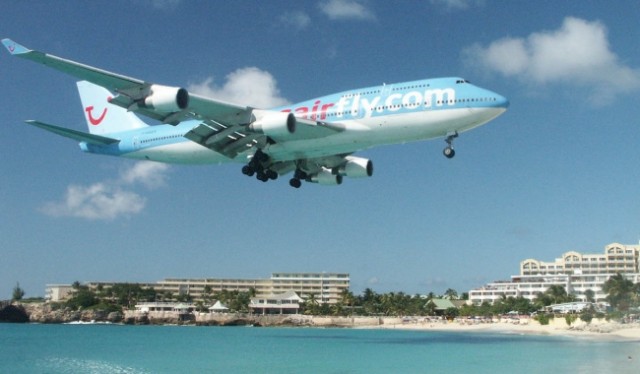
A Corsair Boeing 747-400 lands at St. Maarten. Image by Chris Sloan / Airchive.com.
The cruise will leave from San Juan and travel to Puerto Rico, Barbados, St. Lucia, Antigua, St. Thomas and of course Saint Maarten. With tickets starting at $749 (per person), it is hard to pass up.
I am not fully sure what if my schedule will allow me to attend at this point, but you better believe I will be trying my best to make the journey. If you decided to make the trip, be sure to tell them that AirlineReporter.com sent you. Hope to see you there.
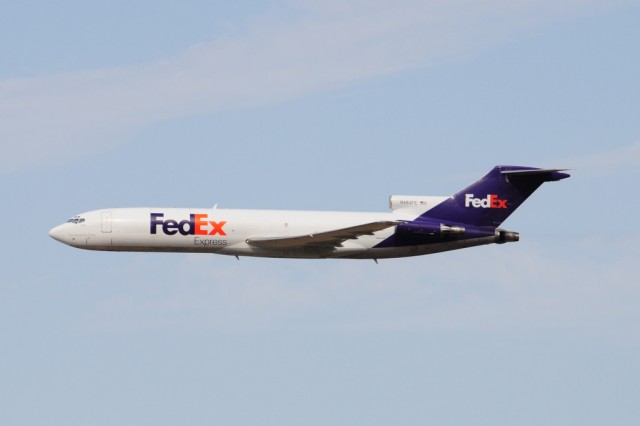
FedEx Boeing 727, named Colin, arrives to Kansas City. Image by JL Johnson.
A blog reader and aviation fan, JL Johnson (@user47), was recently able to witness the last flight and donation of a FedEx Boeing 727. He agreed to share his story and photos with the blog. Here is his story in his own words:
I suspect it’s no news to readers of
AirlineReporter.com, but we aviation enthusiasts are a unique group of folks. Of all the peer-groups I belong to, aviation geeks, that is, avgeeks, are the most loyal, diverse, and enthusiastic I have encountered. One thing I’ve noticed about avgeeks is they always want to deepen their bonds and connections to the industry. Whether it’s catching the newest livery while plane spotting and sharing it on social media, hopping on an inaugural flight, or social networking our ways into typically non-public areas with great aerodome views, we’re always curious. And, with this, I’ve noticed a trend.
It seems the vast majority of folks are focused on what’s new: New planes, new routes, new airlines, etc. And while this is great, it seems I’m more interested in what’s old. Maybe it’s my obsession with history, but I want to be a part of, or at least witness history. Recently, I got that opportunity.
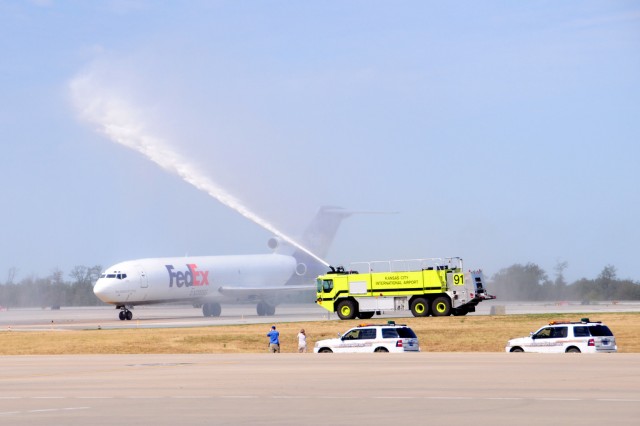
A proper airport welcome at KCI. Image by JL Johnson.
On Wednesday, August 1st at 10:14 AM CDT, a 34-year old Boeing 727 with registry N483FE touched down on Kansas City International Airport’s (KCI) runway 19R marking the end of its life with 34,671 flight hours.
The plane, named Colin, after the child of a FedEx courier, was originally delivered to Braniff Airways in 1978 as a passenger liner. In May of 1990 FedEx Express took ownership of the plane and oversaw its passenger to freighter (P2F) conversion. Shortly after, it entered the FedEx Express fleet where it served alongside dozens of other 727s for 22 years.
While the termination of FedEx Express flight 9044 from Memphis, TN marked the end of the sky for a plane, it highlights a quickening retirement plan for this and other tri-jets in fleets across the world. With higher maintenance costs for older planes and drastically more fuel-efficient alternatives on the market, planes like Colin have quickly fallen out of favor.
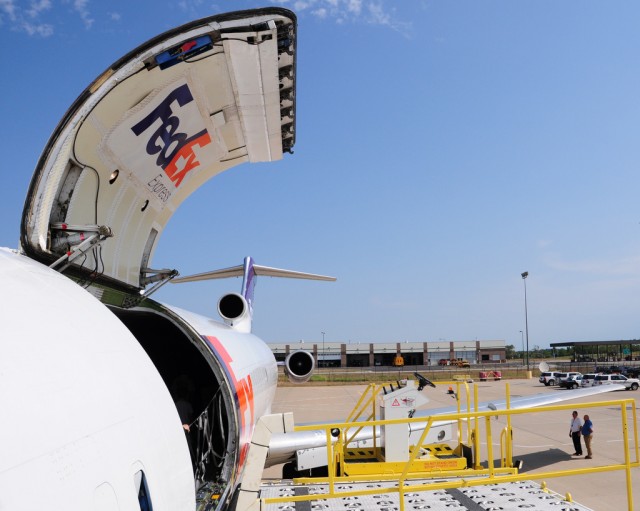
Those Boeing 727s that were converted to freighters increased their lifespan, but for Colin, he is about to start a new chapter. Image by JL Johnson.
So, what’s one of the world’s largest airlines to do with all of these old fuel inefficient planes? According to David Sutton, managing director of Aircraft Acquisition and Sales for FedEx, the solution was simple: Donate the planes to the communities they serve to support educational endeavors.
In 1995 FedEx Express launched their aircraft donation program with the donation of a plane to the FAA who at the time was interested in studying the effects of corrosion and fatigue on aging aircraft. Since then FedEx has donated over 50 airplanes to charities, museums, and airports.

You are not a true avgeek if you don’t love a tri-holer. Image by JL Johnson.
Kansas City Aviation Director Mark VanLoh gladly accepted FedEx’s donation which the airport intends to use for emergency response training. Mr. VanLoh shared with the audience that with this plane, the airport and its crucial emergency responders will no longer be reliant on the generosity of its constituent airlines to loan their planes for training exercises.
In the coming days Colin will be relocated to the southeast side of the airport near an on-site overhaul base where it will lose its engines. While two of the engines will in some fashion make their way back into service, via parts or spares, one will be preserved and donated to the National Airline History Museum where patrons can visit and learn about the low-bypass jet engines that helped usher in the modern era of aviation.
37 PHOTOS FROM THE FEDEX EVENT
About the author: I’m a Kansas City, Missouri based Senior Business analyst with a ridiculous obsession for all things aviation. As an avid plane spotter, I can often be found on or near airport property with a telephoto lens. Let’s get social! I’m on twitter and most other social media as @user47 and occasionally blog over at http://jlsblog.com
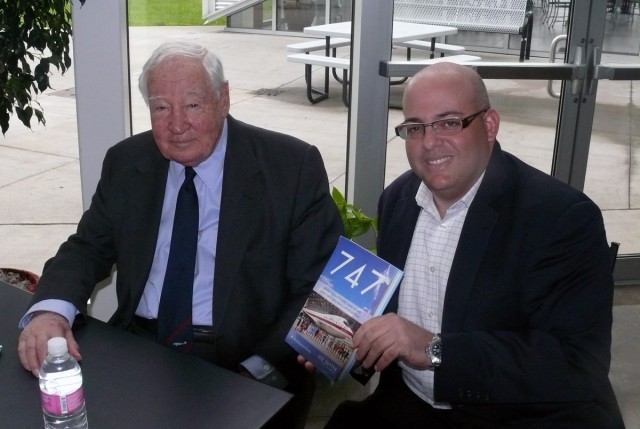
Chris Sloan (on the right) gets his Boeing 747 book signed by Joe Sutter (father of the 747) during the recent Lufthansa 747-8I Delivery.
I first met Chris Sloan during ANA’s delivery celebration of their first 787 Dreamliner. However, I already knew his name. I had previously seen his work in Airways Magazine and I knew of his site Airchive.com, although I didn’t realize he was the man behind it. We have quickly bonded over airlines and enjoy sharing our unique stories with each other.
When it comes to airline collections, there is no question that Chris has me beat. He has so many airline collectables it blows the mind. Luckily he has spent a great deal of effort to share his collection with the rest of the world. I wanted to learn a bit more about him and his website. Here is our interview:
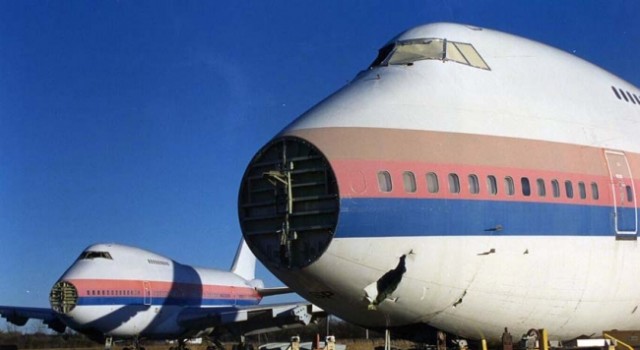
An old United Airlines Boeing 747-100 and 747SP at Ardmore Graveyard. Photo by Chris Sloan / Airchive.com.
AirlineReporter.com (AR): What is Airchive.com?
Chris Sloan (CS): Airchive.com is what I call an online ’œwebseum of commercial aviation’. I strive to be different from other sites out there that do pure plane-spotting, breaking news, and travel reviews so well. We are basically an online museum of commercial aviation with some contemporary twists:
We curate timetable, route maps, airline and manufacturer memorabilia of 1000s of airlines going back to the 1920s to the present. We really try to write a historic perspective of the history of an airline or aircraft model through it’s memorabilia and route maps.
Another thing that sets us apart is our focus on airports. Lots of attention, and rightly so, is directed to plane spotting which Airchive.com does but we feature virtual in-depth photographic tours and background info on airports around the world. We are as interested in the terminals as we are what’s on the ramp. Likewise, these virtual tours extend to aviation museums with slide-shows that transport the user there virtually. One of our most popular sections are rare photographic behind the scenes tours of airplane manufacturers such as Boeing and Airbus
Other unique features include detailed galleries on airliner cabins, scrapped airliners, airline models (including cutaways), and aviation firsts such as trip accounts of the inaugurals of the Airbus A380, Boeing 787 Dreamliner, and the upcoming Lufthansa Boeing 747-8 Intercontinental Inaugural.
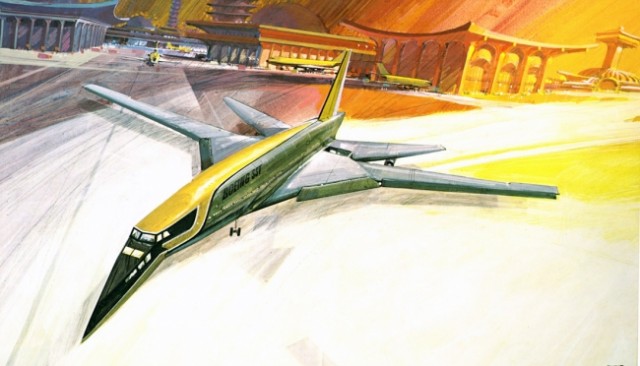
An image from the Boeing SST 2707 brochure from 1966. Chris Sloan / Airchive.com
AR: Why did you start it?
CS: I started the site back in 2003 as a way to give back to the commercial aviation community and share my massive collection as others had done online in person. It has turned into a passion project which has allowed me to meet many other folks of similar passion and undertake unique experiences. Also, at this time, the airline industry was engaged in the nadir of it’s turmoil following 9/11 and running up to the Gulf War II, so I wanted to remind the flying public and airline staff just what an incredible industry they have. I now try to tweet @airchive relevant items everyday to provide a historical or different take on what is in the airline zeitgeist.
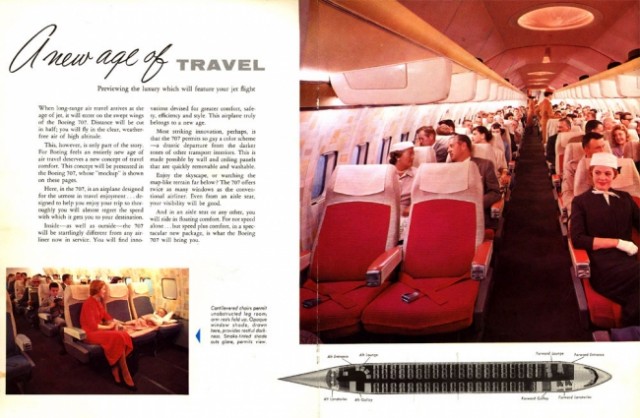
1955 Boeing 707 Intro Brochure. Image from Chris Sloan / Airchive.com.
AR: When did you get into collecting airline memorabilia?
CS: I began collecting at the age of 6 years old. I would visit airports and city ticket office’s back then when those existed, and pester airline reservation agents to mail me timetables, route maps, safety cards, whatever. I’d also inhabit my favorite airports snapping off photos. It’s a life-long passion but I frustrated that I didn’t have anyone to share it with. At this point, my model collection numbers over 300 including gigantic 747, DC-10, and Concorde cutaways; 10,000 timetables, brochures, airline seats, service items, even a desk made from the wing of the Lockheed L1011 prototype. I am not in this for the money. In fact, to borrow an old stock market adage ’œI buy and hold.’ I have never sold anything, though have donated and loaned items to other museums.
As I have grown older running my own TV production company which leads to extensive travel ’“ this only increases my enthusiasm for this fascinating industry. One cool thing is I have combined some business with pleasure such as overseeing the John Travolta hosted documentary on the building of the Airbus A380, back when I ran production at TLC, and now creating and executive producing a reality series called ’œAirport 24/7: Miami’ which is an unprecedented behind the scenes look at all the goings on at Miami International Airport. It’s a compelling, eye opening show for enthusiasts and non-enthusiasts alike. It will premiere later in the Summer on Travel Channel.
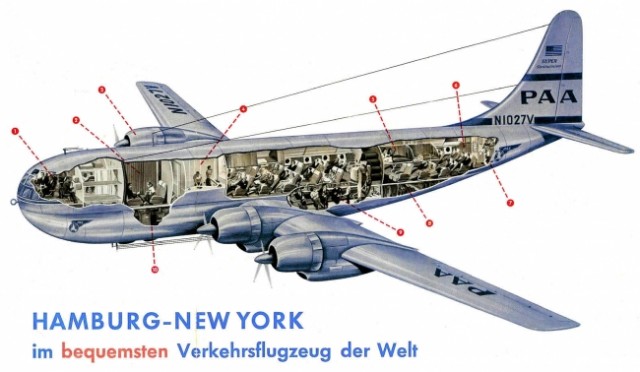
Cutaway of a Pan Am Boeing 377 Stratocruiser. Image from Chris Sloan / Airchive.com.
AR: Have you ever thought of starting some in-person museum?
CS: This is a long-term goal, or if I win the lottery a short-term goal, to either start my own or collaborate with others of like-minded interest. My ’œdreamseum’ would be a cross between LAX’s Flightpath Museum and the Delta Airlines Heritage Center and American’s C.R. Smith Museum. It would cover a broad swath of airlines like Flightpath but with the depth and actual aircraft of C.R. Smith and Delta Heritage. As a passionate Miamian, I would like it to have a South Florida focus on Pan Am, National, and Eastern.
I have taken part in public displays where I loaned materials out. There was a Museum of Modern Art (MOMA) Exhibit at the former TWA Terminal T5 @ JFK a few years back, but unfortunately about $5000 of my collection was stolen and never recovered so I am much more careful these days. Who would’ve thought MOMA didn’t carry insurance.
AR: What is your favorite piece you have on the site?
CS: Hard to say, so I will list some of my favorites:
* Boeing brochure for the 2707 SST
* The original US Air Force presentation for Air Force One
* Anything and everything involving my favorite airlines: Delta, Pan Am, Continental, Braniff, and National
* Complete timetable collections for major U.S. airlines going back to their histories
* My young son has come now has the bug. In fact, he is named after artist Alexander Calder who designed the Flying Colors Boeing 727 for Braniff. I have an autographed poster from Calder.
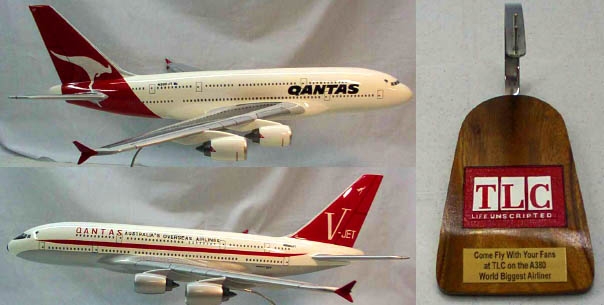
A special Qantas Airbus A380 model given to Jon Travolta. Photo by Chris Sloan / Airchive.com.
AR: What has been your favorite airline related experiences?
CS: Shooting with John Travolta the A380 doc was incredible. Such a gracious man and an enthusiast extraordinaire. As a reward, we all went up in an Airbus A-320 chartered for the shoot, and he took the controls. It has also been exciting being a part of three inaugurals and deliveries including the Airbus A380, Boeing 787 Dreamliner and the Lufthansa Boeing 747-8 Intercontinental.
Meeting the Father of the Boeing 747, Mr. Joe Sutter at the Lufthansa Boeing 747-8 Intercontinental Delivery. Spunky, Pugnacious, and Outspoken’¦

Eastern Air Lines Douglas DC-7B at Opa Locka - August, 2010. Chris Sloan / Airchive.com.
Chartering the world’s only flying passenger DC-7 for a company party high over Miami. We buzzed the beach at 1,000 feet. Travolta and his daughter came on one of our flights from Miami to Key West where Pan Am was founded. Countless private ramp tours of LAX, Miami, and Mojave. These are hard to get and very gratifying, especially when friends and family have joined in awe as an A380 lands 100 feet away.
Flying the jump-seat from LAX to Hong Kong on a Boeing 747-400 back in 1999. Visiting the not open to the public Boeing Archives. The Airline Reporter has been there too, so you know how awesome it is.
Photographing the Boeing and Airbus Factories and Customer Delivery Centers and flying a CRJ-200 sim through moderate to serve turbulence, with the radar painting read, and trying not to throw up!
Being on the inaugural of the Virgin America service to Florida with my idol, Richard Branson.
Producing our Travel Channel Series about the Miami International Airport. We actually created an airborne parade of a DC-7 and DC-3 which proceeded the Lufthansa A380 landing in Miami for the first time. And of course, all the international travel such as flying into Hong Kong Kai-Tak during its last days.
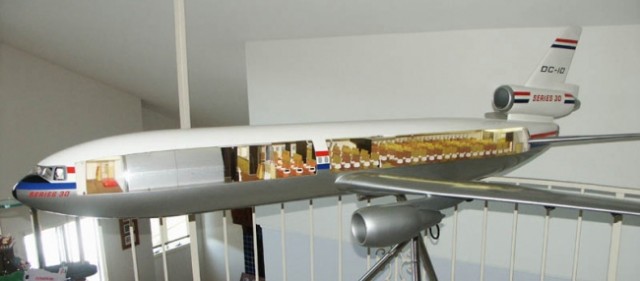
A very rare 1973 vintage factory DC-10 cutaway. Image from Chris Sloan / Airchive.com.
AR: How many airline models do you have?
CS: 100’s literally but the pride and joy are 3 restored cutaways: 1 of 3 Douglas DC-10 Prototypes made for the factory back in the 1960s to demo the airplane. Also a Concorde cutaway that used to apparently be in the lobby at the Bristol Fulton Factory. It was in found in the attic of the interior designer of the Concorde, after 20 years.
I also have a 7 foot long 1974 circa TWA Boeing 747 restored over 3 years to its original condition and an original Boeing 747 prototype cutaway circa 1969
AR: What is Airchive.com’s relationship with Airways?
CS: I have been an avid reader of ’œAirways’ since it began publishing. In fact, I deserted commercial aviation for many years until 1994 when I picked up one of their first issues in an airport newsstand. I was immediately infected again by the bug. I still eagerly await my issue each month like every other enthusiastic subscriber. We have a strong cross-promotion and content-sharing relationship. As well, I am a frequent contributor to this excellent publication as it really speaks to my passion.
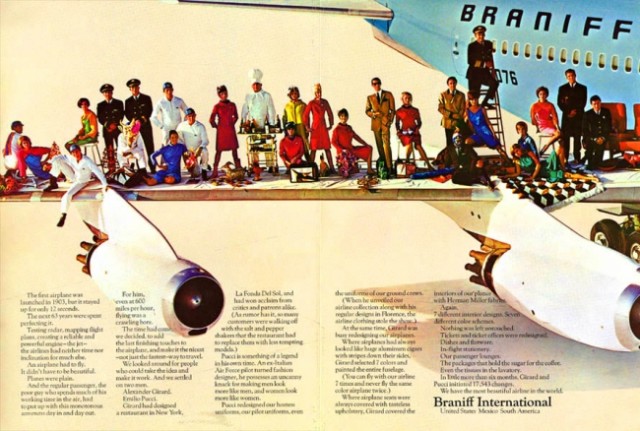
1965 "End of the Plain Plane" ad campaign for Braniff. Image from Chris Sloan / Airchive.com.
AR: What do you want to add?
CS: I view Airchive.com as pure passion. It takes a lot of time and money, frankly but it is a passion. It has been so much fun, particularly getting my sons interested in this field and meeting so many interesting, like-minded people. I get a lot of gratitude when people write from around the world how much the site inspires them or takes them back to memories they had in the business. When someone says ’œI got lost for hours on Airchive’, that is the greatest compliment. I am adding features to allow more contributors as many wonderful folks send me items and photographs. As my children get older and business obligations grow, it gets harder to do this on your own. So I welcome anyone who wants to get involved and collaborate. We’re all stronger together then apart.
Do you own an older Boeing 747 and are looking to improve the way it looks? Does your upper deck just look so small compared to the 747-300, 747-400 and especially the 747-8I? Well, do not worry… Boeing has a deal for you: the 747 Stretched Upper Deck (SUD). Well, I guess Boeing had a deal for you, since they aren’t in the business of doing this anymore.
The SUD gave airlines operating older -100 and -200 747 models, the ability to stretch the upper deck and increase the number of passengers flown. When plane spotting, it is typically easy to tell the difference from a 747-100/200 and the 747-300 by check out the stretched upper deck, but the SUD makes it a bit more complicated.

CLICK FOR LARGER: Information for airlines on the Boeing 747 Stretched Upper Deck. Image from Boeing.
From the image above: “The design of the Stretched Upper Deck option allows a 10 percent increase in capacity with only a 2 percent change in operating empty weight. This means added profit potential, lower seat-mile costs and 5 percent lower fuel consumption per available seat-mile.”
“This new option, available for the -100B/SR/-200B and -200B Combi models adds 280 inches of structure to the upper deck cabin.”
“The change is accomplished using current engine options and brake release gross weights of -100B/-200B models. Five maximum brake release gross weights are available ranging from the basic weight of 775,000 pounds (351 520 kg) to 833,000 pounds (377 780 kg). In addition to the basic JT9D-7AW, the -200B Stretched Upper Deck option is available with the following optional engines: Pratt & Whitney JT9D-JFW, -7J, -7Q and -7R4G2, General Electric CF6-50E/E1/E2 and Rolls-Royce RB211-524B2/C2/D4.”
“Weights and selected performance are presented on the following pages for only the 747-200B Stretched Upper Deck. 747-100B/SR and Combi performance is not shown.”
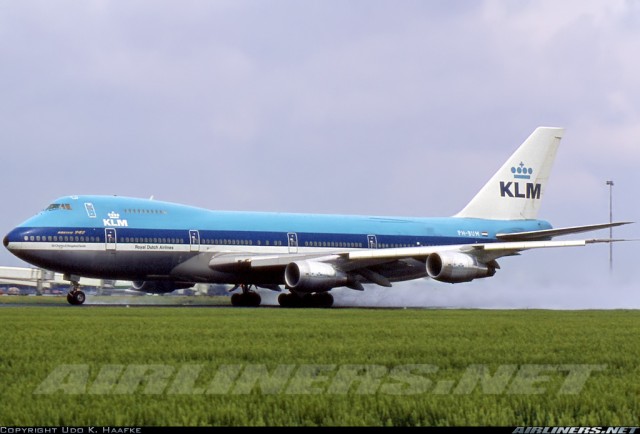
KLM Boeing 747-200 (PH-BUM) tkaen in May 1980 before the SUD upgrade. Photo by Udo Haafke.
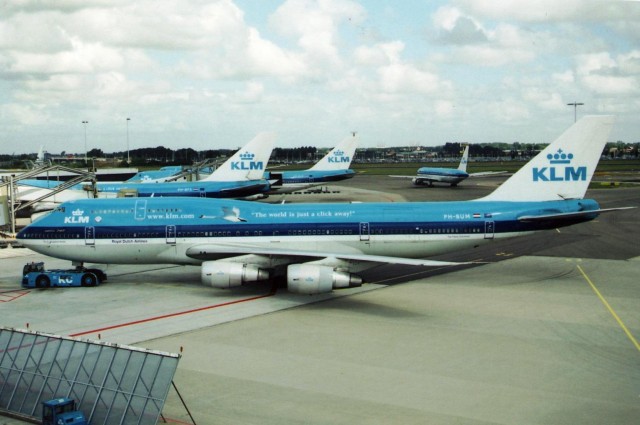
The same KLM Boeing 747-200 (PH-BUM) now with a Stretched Upper Deck. It looks like a Boeing 747-300, but really is still a -200. Taken in August 2003. Photo by Savvas Garozis.
Images by Udo K Haafke and Savvas Garozis
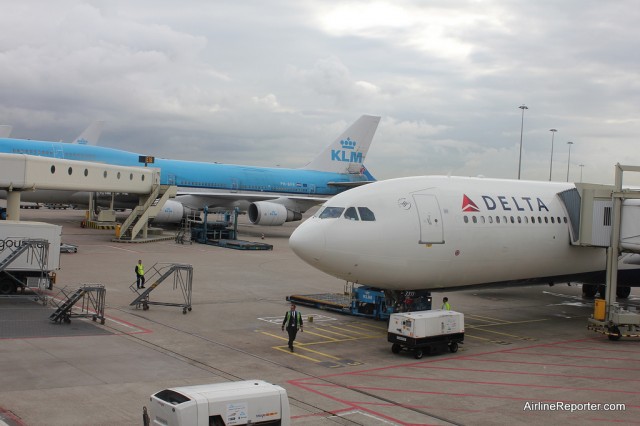
Delta Air Lines Airbus A330 with a KLM Boeing 747-400 in the background in Amsterdam.
This was my last leg of my RwandAir adventure. I had already flown from Seattle to Rwanda in a 737 and just completed a 10 hour flight from Kigali, Rwanda to Amsterdam on a KLM A330. I was already pretty tired and wasn’t sure how my mind, body and spirit would do on another ten hour ride in a different A330. On the positive side, I was looking forward to comparing two international Airbus A330s back-to-back. Overall, I have to say I like the Northwest Delta Air Lines A330 long haul premium economy a bit better than KLM’s.
When arriving into Amsterdam, I had a three hour layover and I was hoping to check out their observation deck. Before plane spotting, I needed to do some charging of my laptop and cell phone, since my last ten hour flight did not have in-seat power and neither would my next one. The classic hunt for an open outlet was on.
I started down the concourse looking from side to side. I kept going and going and’¦ well, going. Seriously? After 45 minutes looking up and down concourses D, E and F, I found an outlet about seven feet up for vending machines, one in the bathroom, one on a fire hose holder and one on a center pillar in a crowded walkway. I choose to deal with the crowds and sat down on the floor (looking like an idiot by the way) by the pillar, plugged in my phone and then’¦ nothing. Sweet, this outlet did not work. Now the debate was did I want to look like even more of an idiot standing in the bathroom charging my phone, climbing on a vending machine or using an outlet on a fire hose that might cause some alarm to go off. I figured my best bet was with the fire hose and luckily it worked. The bad part was it took so long to juice up, that I wasn’t able to check out the observation deck ’“ save it for next time I guess.
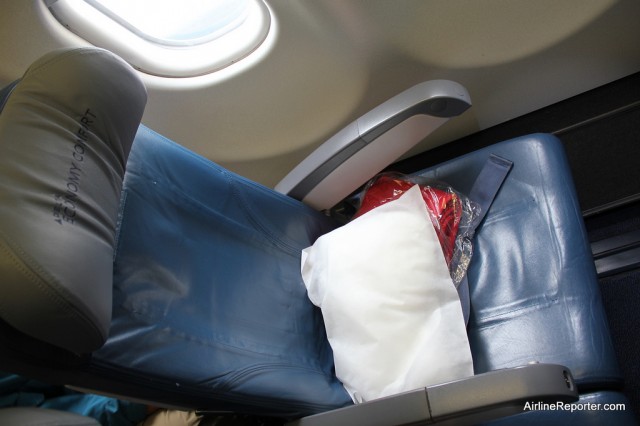
Delta Economy Comfort seat on an Airbus A330.
I figured I might as well head to the gate, where I received my first body scan. We had to wait in a small waiting area at the gate for our flight, which had little entertainment before being able to board. I was sitting in Delta Economy Comfort, which gave me four additional inches of seat pitch, 50% more recline, priority boarding and free alcohol. You also sit near the front of the plane, which means you are first to customs after arriving in Seattle. .
Even with the extra four inches, I was unable to fully stretch out my legs since there was a huge in-flight entertainment box under my seat, negating the extra leg room. You would think with a large electrical box like that under your seat, they would at least give you an outlet, but there was none. Reading on SeatGuru.com, it looks like only Business Class has outlets. Good thing I did some charging during my layover.
One nice surprise was seeing an air vent in the overhead bin. I absolutely love my air vents, since I am normally hot and that little breeze can make a huge difference. Sure, most domestic aircraft have air vents, but I am finding more and more long haul Boeing 747, 777, Airbus A330/A330 and the A380 are lacking them.
During both legs (KGL to AMS and AMS to SEA), I had window seats. When flying on the KLM A330, I noticed that there was quite a bit of room between the seat and the wall and was wishing the outer arm rest would raise, allowing me access to that extra room. It was too bad that the armrest would not rise on the KLM A330, but it did rise on Delta’s. This gave me an extra three inches or so of seat width and I was starting to get the feeling that this might be a good flight. Unfortunately we ran into some trouble pretty quickly.
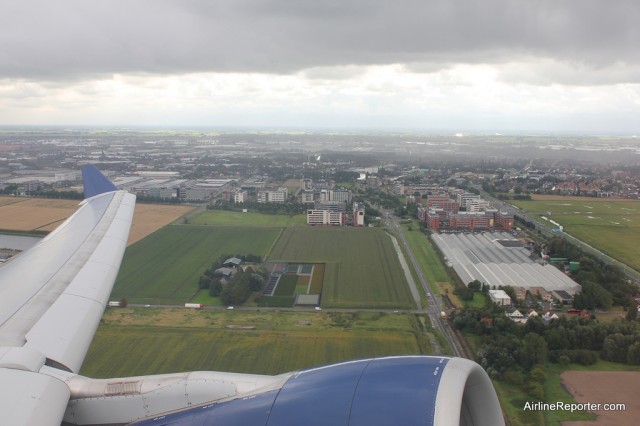
Taking off from Amsterdam.
After boarding we were told there would be a delay. It turns out that the amount of fuel that the truck indicated being pumped into the aircraft, didn’t match the A330’s gauges. Delays can be annoying, but I am willing to wait to make sure we have enough fuel — I am old fashioned like that. It took about an hour to determine that the truck had the failure and after all the paperwork was completed, we took off.
When getting my free headphones given by Delta out of their plastic bag I accidently ripped one of the wires. Not a big deal, I figured I could just ring the call button and quickly get a new one. I decided to try something new; time how long it would take for a flight attendant to assist me after ringing the call button. I decided I would make eye contact with a flight attendant walking by, but I would not say anything like “excuse me,” to put them to the test.
I rang the call button and waited. And waited. And holy crap waited some more. At the 10 minute mark I turned off my call light and rang it again. During those ten minutes I had two different flight attendants walk by, but they did not stop’¦ they did not even make eye contact. At the 15 minute mark I turned off my call light and rang it again. Another flight attendant walked by, but still nothing. I could see that my call light was on and the “ding” noise was definitely making its sound.
At about 18 minutes a flight attendant came by for trash. I was waiting for her to ask me about my light, but she didn’t. I decided I really wanted to start watching a movie, so I asked her for another head phone set, which she got right away. I am not normally one who uses the call button and I have never timed it before, but I am pretty certain that 18 minutes and three flight attendants walking by is not okay. It takes a lot to get me annoyed or frustrated on a flight and this definitely did it.
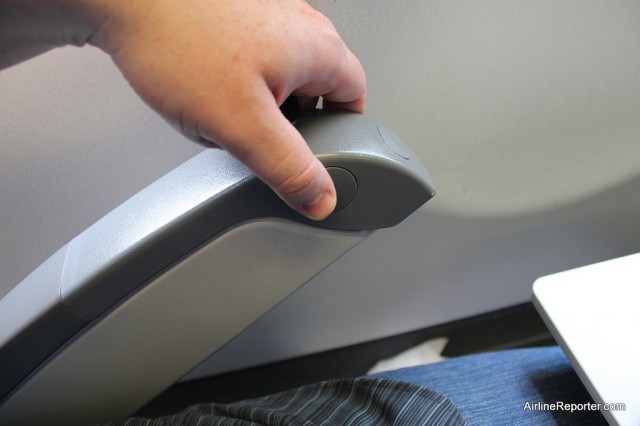
OH YES! The armrest near the window moves, giving me more room.
When trying to relax, the recline of the Economy Comfort was great. However, when the person in front of me was enjoying their extra 50% recline, it was not so great ’“ actually pretty annoying. I am normally one that doesn’t recline my seat, since I do not want to disturb the person behind me, but I really had to recline a bit to open my laptop, even with the extra four inches.
During the flight, I was served two different meals. One was your standard airline pasta, but the second was pizza. Both of them were pretty decent and I thought it was pretty slick having pizza on the plane. I really didn’t get to enjoy all the amenities in the flight, since I slept through most of it. Having the ability to raise my outer armrest really gave me one of my best economy sleeps with someone sitting next to me. I landed in Seattle feeling a lot better than I thought I would after 24 hours of economy flight.
A FEW MORE PHOTOS





















